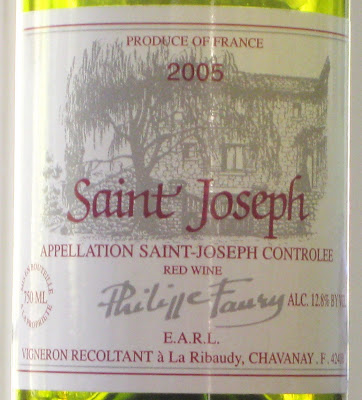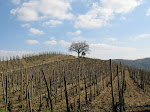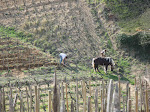
Burgundy contains many hidden little treasures for the adventurous wine drinker, but all the big prizes have already been discovered. I believed this to be true until one day this past spring while on expedition in Burgundy. On March 19th, 2008, I was present when the wine equivalent of King Tut's tomb was unearthed. Our group had already tasted at six domaines and were on pace to be late for the seventh, but our French business associate insisted that we visit an estate in Givry. There are some nice wines made in Givry, but we had just tasted our way through Chassagne and Puligny, and the prospect of visiting a Chalonaise domaine was not very appealing. Our French colleague, however, proved very persuasive and we turned the car south towards Givry. We pulled into a small courtyard and within seconds were descending into an 18th century dungeon-like cellar. A white haired man wearing mostly black escorted us to a barrel labeled 'Givry blanc'. This mysterious figure had only been introduced to us as 'The Baron.' I stuck my weary nose into the glass and then took a swig. The wine was refreshingly mineral and crisp. A Givry rouge followed and I was taken aback by the beautiful structure the wine possessed. Firm tanins coated my mouth. I looked around the cellar and noticed several huge open top barrels lining the walls. The Baron announced that the next wine was Corton, Clos du Roi, and it proved to be a perfect expression of that vineyard. Next up, Les Grands Echezeaux. Wow! The Grand Echezeaux was spicy and very long on the finish. We followed the Baron to another stack of barrels. I rubbed my eyes to make sure my sight was not blurred from too much wine. 'Montrachet' was etched across the front of the casks. Bracing myself, I took my first ever sip of a wine from this mythical vineyard. The wine was golden in color, rich on the palate and full of liquid stones. It sat in my mouth and refused to leave.
"Is that really seven barrels of Montrachet?" I asked.
"Yes", our French associate replied. "The other 18 went to negociants."

The Bordeaux-Montrieux family has owned land in Givry since 1760, but for the past several decades their estate, Domaine Thenard, has sold most of its production to the negociant Maion Roland Remoissenet. While wine was released under the Thenard label at the domaine, Remoissenet requested that the wines not be exported to the U.S. market. In 2005, Remoissenet was sold to to a group of North American investors led by the Milstein brothers of New York and the Thenard estate decided to explore export options.
 An interior view of the entrance to Domaine Thenard's cellar.
An interior view of the entrance to Domaine Thenard's cellar.The estate was founded in 1842 by Baron Paul Thenard, who married a local girl with the last name of Bordeaux-Montrieux. In subsequent years, control of the domaine passed through the female side to the Bordeaux-Montrieux descendants. Despite being virtually unknown in the U.S., Domaine Thenard has been famous in Burgundy for over a century due to one monumental purchase. Two large parcels of Le Montrachet, totaling 1.86 hectares, were acquired by Baron Paul Thenard in 1872. Only the Marquis de Laguiche, with their single parcel of 2.06 hectares (Puligny side), own more land in this fabled vineyard. By comparison, the third largest owner in Montrachet is Bouchard Pere et Fils with 0.89 hectares. In the 20th century, the grand cru vineyards Clos du Roi in Corton and Les Grands Echezeaux in Flagey were added to the portfolio. These vineyard acquisitions made Thenard one of the most important estates in Burgundy, yet the heart of the domaine remained in the humble village of Givry.

Baron Jean-Baptiste Bordeaux-Montrieux
Baron Jean-Bapstiste Bordeaux-Montrieux has been in charge of the winemaking at the domaine since the earily 1980's, but most of the wine was sold to Remoissenet while still in barrel. The bottles sold under the Remoissenet label were not held in high esteem, but the cuvees purchased from Thenard stood out. In his description of Remoissenet, Clive Coates (The Wines of Burgundy, University of California Press, Berkeley, 2008) wrote, "the firm distributes the wines of Domaine Baron Thenard and these - Le Montrachet, Corton Clos du Roi, Grands Echezeaux - are often the best." Maison Entienne Sauzet also purchases the Montrachet in must form from Thenard and this is the sole source for their much sought after cuvee. Today, the Baron holds back the top cuvees for the estate and controls every step of the winemaking. The wines bottled under the Domaine Thernard label are serious vin de garde (wines to keep). I was blown away by a 1976 Givry rouge tasted at the domaine during our visit. Amazingly, the wine was still very much alive.
 The open top tuns used for the fermentation of the Givry rouge.
The open top tuns used for the fermentation of the Givry rouge.
The winemaking at Domaine Thenard is very tradtional and the wines have a firmness/rusticisty that reflect that style. The domaine's largest holding in Givry is in the premier cru Les Bois Cheveaux (7.66 ha), which tends to show slightly more power then the Givry premier cru Cellier Aux Moines (3.22 ha). Also in Givry is the premier cru Clos Saint-Pierre (2.12 ha). This vineyard, which is a monopole of the estate, produces the darkest colored and most ageworthy of the three Givry premier cru. In Pernand-Vergelesses, Thenard owns a piece of the finest vineyard in the village, Illes des Verglesses (0.85 ha). Right next door, on the hill of Corton, sits the domaine's prime parcel in the great Clos du Roi (0.9 ha ). The top section of Clos du Roi, where Thenard's vines are located, is considered superior to the lower portion of the vineyard and produces one of the more underated grand cru in Burgundy. Clive Coates considers Clos du Roi to be one of the very best vineyards in the Cote d'Or, on par with La Romanee Conti, La Tache, Chambertin and Le Musigny. Also included by Coates with those legendary names is Les Grands Echezeaux, of which Thenard is fortunate to own 0.54 hectares.
Three white wines are made at Domaine Thenard. The basic Givry blanc is fresh and bright. Far richer and more intense is the Chassagne-Montrachet, 1er Cru, Clos Saint-Jean (0.17 ha). The show stopper is, of course, the Le Montrachet (1.83 ha). In addition to owning a huge portion of this vineyard, the domaine is also blessed with old vines. The individual parcels were planted between 1931 and 1972. The resulting wine is deep in color and has an intense bouquet of white flowers and spicy oak. In the mouth, the wine is immense, but not heavy. A wave of minerals lurks in the background and keeps the wine from weighing down the palate. Thenard's Montrachet is truly a great wine.

Domaine Thenard owns two parcels in Le Montrachet, both of which can found on this map. Montrachet is divided in two by the Chassagne/Puligny border, which is represented by the dark line running through the vineyard on the right side of the map. The Chassagne half (3.99 ha) is known as 'Le Montrachet' and the Puligny side (4.01 ha) simply as 'Montrachet.' Domaine Romanee Conti owns the first parcel to the left of the Chassagne/Puligny dividing line (#31). Thenard owns the second, much larger plot (#32). The enormous parcel on the upper left hand side of the map (#34) also belongs to Thenard.

I left the domaine in a state of shock. Did I really just taste a Montrachet? Did I really suck down a '76 Givry that was still kicking? The next day, I awoke with a mild headache and descended down to the kitchen for a quick cup of coffee. Our schedule was packed and by 9am we were back in a cellar tasting, this time in Gevrey. A Chambertin-Clos-de-Beze was still fresh on my lips as our car zipped towards to Morey St-Denis, but I could not dislodge the Thenard visit from my mind. How could a cellar with 25 barrels of Montrachet resting inside, not to mention Clos du Roi and Grands Echezeaux, be hidden in total obscurity? I found myself zoning out at our next appointment as I pondered this question. Several reasons came to mind for Domaine Thenard's lack of fame, but none of them mattered now. Burgundy's great hidden treasure has been found--- in Givry of all places.














 An interior view of the entrance to Domaine Thenard's cellar.
An interior view of the entrance to Domaine Thenard's cellar.
 The open top tuns used for the fermentation of the Givry rouge.
The open top tuns used for the fermentation of the Givry rouge. 

